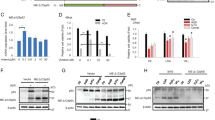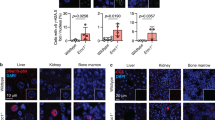Abstract
The mdr1b gene is thought to be a “stress-responsive” gene, however it is unknown if this gene is regulated by p53 in the whole animal. Moreover, it is unknown if overexpression of mdr1b affects cell survival. The dependence of mdr1b upon p53 for upregulation was evaluated in p53 knockout mice. Wild-type (wt) or p53−/− mice were treated singly or in combination with gamma irradiation (IR) and/or the potent DNA damaging agent, diethylnitrosoamine (DEN). Both IR and DEN induced mdr1b in wild-type animals, but not in the p53−/− mice. IR also upregulated endogenous mdr1b in the H35 liver cell line, and the mdr1b promoter was activated by IR and activation correlated with p53 levels; moreover activation required an intact p53 binding site. Colony survival studies revealed that co-transfection of both mdr1b and p53 dramatically reduced colony numbers compared to cells transfected with either p53 or mdr1b alone and cells microinjected with both mdr1b and p53 had a more dramatic loss in viability compared to cells injected with either expression vector alone. Further studies using acridine orange and ethidium bromide to measure apoptosis revealed that mdr1b caused apoptosis and this was enhanced by p53, however the increased apoptosis required a functional p53 transactivation domain. These studies indicate that mdr1b is a downstream target of p53 in the whole animal and expression of mdr1b facilitates p53-mediated cell death.
This is a preview of subscription content, access via your institution
Access options
Subscribe to this journal
Receive 50 print issues and online access
$259.00 per year
only $5.18 per issue
Buy this article
- Purchase on Springer Link
- Instant access to full article PDF
Prices may be subject to local taxes which are calculated during checkout







Similar content being viewed by others
References
Bond TD, Valverde MA and Higgins CF. . 1998 J. Physiol. 508: 333–340.
Chin LS, Park CC, Zitnay KM, Sinha M, DiPatri AJ, Perilan P and Simard JM. . 1997 J. Neurosci. Res. 48: 122–127.
Devault A and Gros P. . 1990 Mol. Cell. Biol. 10: 1652–1663.
Dmitrieva N, Kultz D, Michea L, Ferraris J and Burg M. . 2000 J. Biol. Chem. in press.
Fardel O, Payen L, Courtois A, Lecureur V and Guillouzo A. . 1998 Biochem. Biophys. Res. Commun. 245: 85–89.
Furuya KN, Bradley G, Sun D, Schuetz EG and Schuetz JD. . 1997a Cancer Res. 57: 3708–3716.
Furuya KN, Thottassery JV, Schuetz EG, Sharif M and Schuetz JD. . 1997b J. Biol. Chem. 272: 11518–11525.
Giaccia AJ and Kastan MB. . 1998 Genes Dev. 12: 2973–2983.
Gottesman MM and Pastan I. . 1993 Annu. Rev. Biochem. 62: 385–427.
Gu Z, Flemington C, Chittenden T and Zambetti GP. . 2000 Mol. Cell. Biol. 20: 233–241.
Hupp TR, Sparks A and Lane DP. . 1995 Cell 83: 237–245.
Kojima H, Endo K, Moriyama H, Tanaka Y, Alnemri ES, Slapak CA, Teicher B, Kufe D and Datta R. . 1998 J. Biol. Chem. 273: 16647–16650.
Levine AJ. . 1997 Cell 88: 323–331.
Lin J, Chen J, Elenbass B and Levine AJ. . 1995 Genes Dev. 8: 1235–1246.
Lothstein L, I-Hong Hsu S, Horwitz SB and Greenberger LM. . 1989 J. Biol. Chem. 264: 16054–16058.
MacCallum DE, Hupp TR, Midgley CA, Stuart D, Campbell SJ, Harper A, Walsh FS, Wright EG, Balmain A, Lane DP and Hall PA. . 1996 Oncogene 13: 2575–2587.
Momand J, Zambetti GP, Olson DC, George D and Levine AJ. . 1992 Cell 69: 1237–1245.
Murphy M, Ahn J, Walker KK, Hoffman WH, Evans RM, Levin AJ and George DL. . 1999 Genes Dev. 13: 2490–2501.
Nagaich AK, Appella E and Harrington RE. . 1997a J. Biol. Chem. 272: 14842–14849.
Nagaich AK, Zhurkin VB, Sakamoto H, Gorin AA, Clore GM, Gronenborn AM, Appella E and Harrington RE. . 1997b J. Biol. Chem. 272: 14830–14841.
Naren AP, Cormet-Boyaka E, Fu J, Villain M, Blalock JE, Quick MW and Kirk KL. . 1999 Science 286: 544–548.
Ralhan R, Swain RK, Agarwal S, Kaur J, Nath N, Sarkar G, Mathur M and Shukla NK. . 1999 Int. J. Cancer 84: 80–85.
Rasola A, Far DF, Hofman P and Rossi B. . 1999 FASEB J. 13: 1711–1723.
Raymond M and Gros P. . 1990 Mol. Cell. Biol. 10: 6036–6040.
Robinson LJ, Roberts WK, Ling TT, Lamming D, Sternberg SS and Roepe PD. . 1997 Biochem 36: 11169–11178.
Roemer K and Mueller-Lantzsch N. . 1996 Oncogene 12: 2069–2079.
Santhanam U, Ray A and Sehgal PB. . 1991 Proc. Natl. Acad. Sci. USA 88: 7605–7609.
Schinkel AH, Mol CA, Wagenaar E, van Deemter L, Smit JJ and Borst P. . 1995 Eur. J. Cancer 31A: 1295–1298.
Schrenk D, Michalke A, Gant TW, Brown PC, Silverman JA and Thorgeirsson SS. . 1996 Biochem. Pharmacol. 52: 1453–1460.
Schuetz JD, Schuetz EG, Thottassery JV, Guzelian PS, Strom S and Sun D. . 1996 Mol. Pharmacol. 49: 63–72.
Singh J and Roscher E. . 1991 Mutagenesis 6: 117–121.
Smyth MJ, Krasovskis E, Sutton VR and Johnstone RW. . 1998 Proc. Natl. Acad. Sci. USA 95: 7024–7029.
Spector DL, Goldman RD and Leinwand LA. . 1998 In: Cells: Culture and Biochemical Analysis of Cells. Cold Spring Harbor: Cold Spring Harbor Laboratory Press pp. 15.6–15.7.
Subler MA, Martin DW and Deb S. . 1992 J. Virol. 66: 4757–4762.
Thangaraju M, Sharma K, Leber B, Andrews DW, Shen SH and Srikant CB. . 1999 J. Biol. Chem. 274: 29549–29557.
Thevenod F, Friedmann JM, Katsen AD and Hauser IA. . 2000 J. Biol. Chem. 275: 1887–1896.
Thottassery JV, Zambetti GP, Arimori K, Schuetz EG and Schuetz JD. . 1997 Proc. Natl. Acad. Sci. USA 94: 11037–11042.
Thottassery JV, Sun D, Zambetti GP, Troutman A, Sukhatme VP, Schuetz EG and Schuetz JD. . 1999 J. Biol. Chem. 274: 3199–3206.
Valverde MA, Bond TD, Hardy SP, Taylor JC, Higgins CF, Altamirano J and Alvarez-Leefmans FJ. . 1996 EMBO J. 15: 4460–4468.
Weisburg JH, Roepe PD, Dzekunov S and Scheinberg DA. . 1999 J. Biol. Chem. 274: 10877–10888.
Yonish-Rouach E, Resnitzky D, Lotem J, Sachs L, Kimchi A and Oren M. . 1991 Nature 352: 345–347.
Zambetti GP, Bargonetti J, Walker K, Prives C and Levine AJ. . 1992 Genes Dev. 6: 1143–1152.
Zambetti GP and Levine AJ. . 1993 FASEB J 7: 855–865.
Zhou G and Kuo MT. . 1997 J. Biol. Chem. 272: 15174–15183.
Zhou G and Kuo MT. . 1998 J. Biol. Chem. 273: 15387–15394.
Ziemann C, Burkle A, Kahl GF and Hirsch-Ernst KI. . 1999 Carcinogenesis 20: 407–414.
Acknowledgements
We would like to thank Drs John Cleveland and William Evans for critically reviewing this manuscript. The expert technical advice and assistance of Sarah Bothner in the microinjection core facility at St Jude. Dr Jeff Sample for the Saos-2 cells. Dr Jeff Silverman for the mdr1b cDNA and Dr Alfred Schinkel for the mouse mdr1b RNAse protection probes. This work was supported by National Institute of Health Research Grants ES05851, ES08658, CA63203, CA23099 and P30 CA21765 and by the American Lebanese Syrian Associated Charities (ALSAC). V Lecureur and JV Thottassery contributed equally to this work.
Author information
Authors and Affiliations
Rights and permissions
About this article
Cite this article
Lecureur, V., Thottassery, J., Sun, D. et al. Mdr1b facilitates p53-mediated cell death and p53 is required for Mdr1b upregulation in vivo. Oncogene 20, 303–313 (2001). https://doi.org/10.1038/sj.onc.1204065
Received:
Revised:
Accepted:
Published:
Issue Date:
DOI: https://doi.org/10.1038/sj.onc.1204065
Keywords
This article is cited by
-
Tissue-specific alterations in expression and function of P-glycoprotein in streptozotocin-induced diabetic rats
Acta Pharmacologica Sinica (2011)



